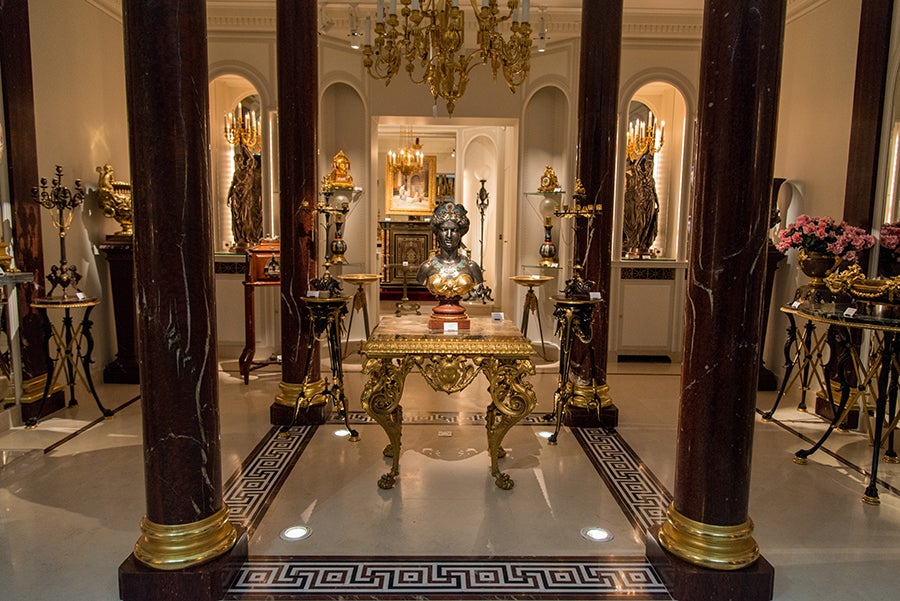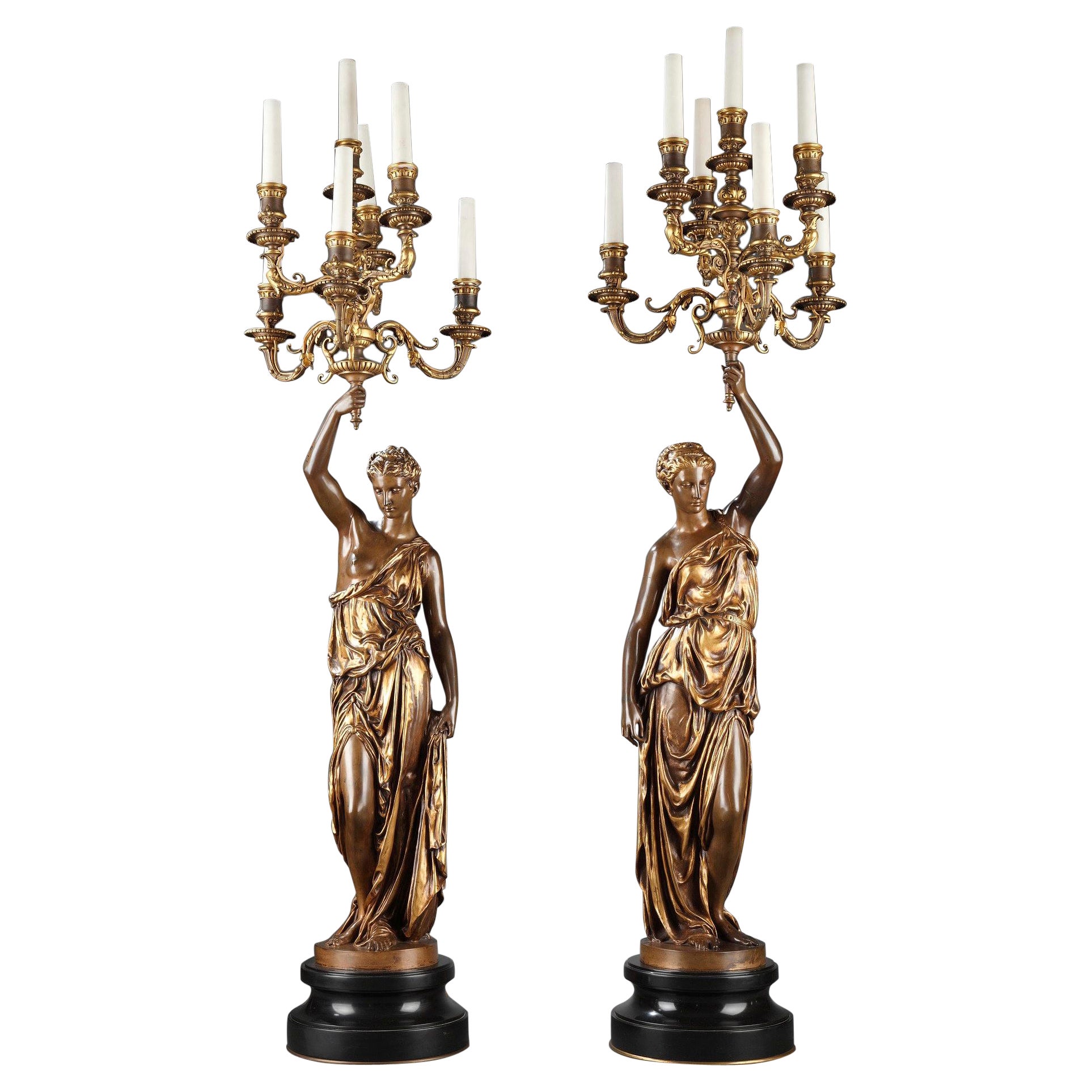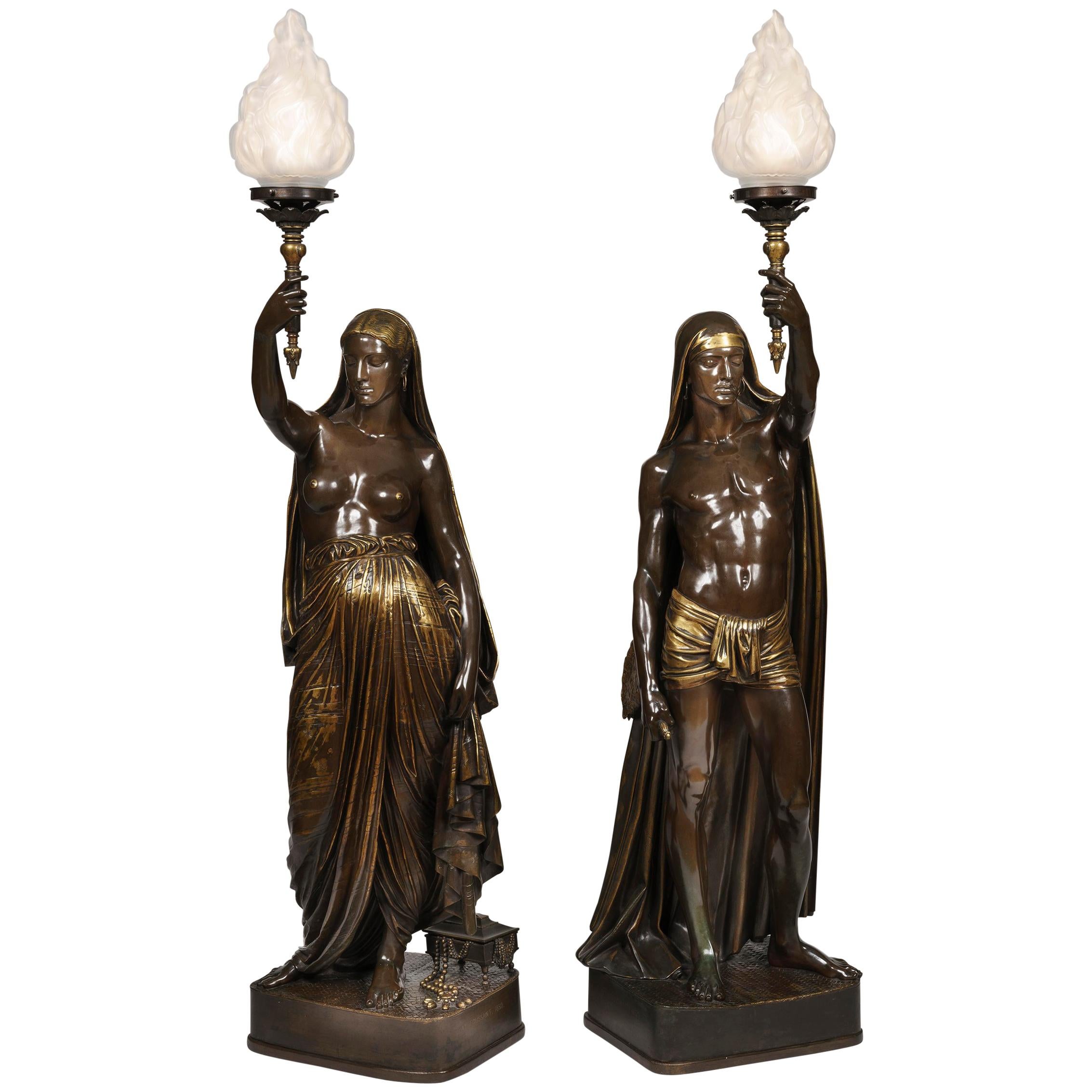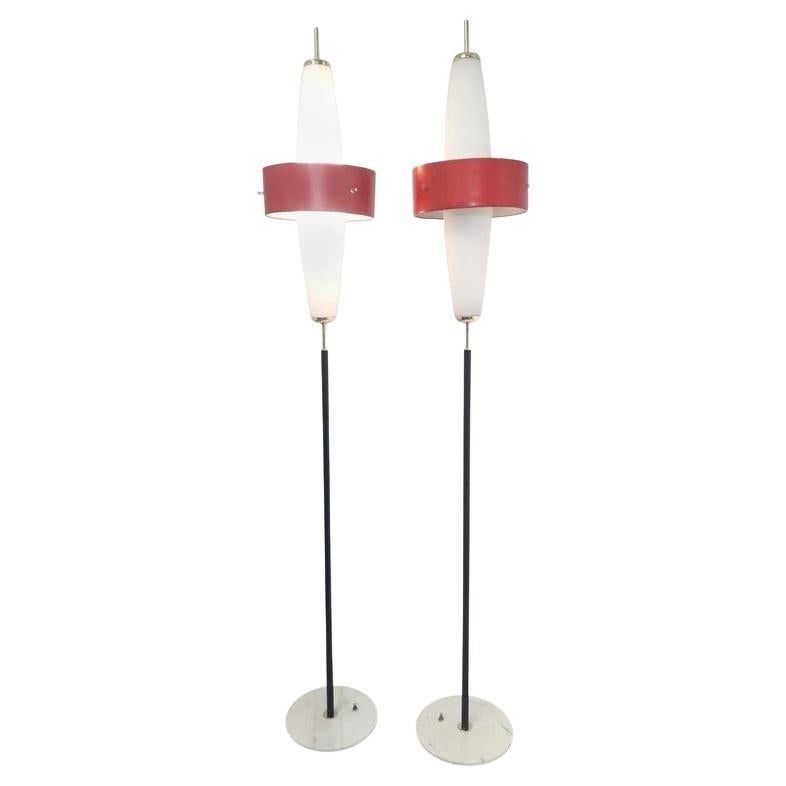Items Similar to Pair of "Indian Slave" Torcheres by Toussaint & Barbedienne, France, circa 1850
Want more images or videos?
Request additional images or videos from the seller
1 of 13
Pair of "Indian Slave" Torcheres by Toussaint & Barbedienne, France, circa 1850
About the Item
Signed Ad Toussaint 1850 and F. Barbedienne Fondeur
Stamped Achille Collas Réduction Mécanique
Torcheres – height : 148 cm (58 1/4 in.) ; width : 34 cm (13 1/3 in.)
Pedestals – height : 83 cm (33 in.) ; width : 48 x 46 cm (19 x 18 in.)
Total height : 231 cm (91 in.)
Pair of gilt-and-patinated bronze oriental figures holding candelabra. Each semi-draped male or female Eastern figure, the female standing beside a box of jewels, the male holding a fan. Resting on a quadrangular base.
The Indian Slaves by Toussaint are reproduced in the Barbedienne’s Art Bronzes Catalog of 1911.
The « Mechanical Reduction » stamp of A. Collas to be seen on these figures reminds us of the association between Collas and Barbedienne. In fact, beginning in 1839, Barbedienne went into partnership with Achille Collas (1795-1859), the inventor of the process of mechanical reduction, allowing Barbedienne not only to produce bronze pieces of different sizes, but more especially to take pride of place in the artistic bronze industry.
“L’Esclave indienne portant une torche” and “L’esclave indien portant une torche” are reduced versions of the plaster exhibited by Armand Toussaint at the 1847 Salon. These are the only known orientalist works of the sculptor. Most of his creations, more academic are related to monuments decoration (Palais de Justice de Paris, Notre-Dame de Paris, Bourse de Marseille).
In February 1850, the French Department of the Interior orders the sculptor a bronze version of these two works for the Palais de l’Elysée . The pair is exhibited at the 1850-1851 Salon (n°3599) and is still in the Interior Ministry, main staircase of the Jean Moulin building, 1bis place des Saussaies. The two sculptures have been added to the inventory of the Mobilier National since 1990 (GML 10258/1 et 2).
In 1855 this pair of torcheres appears in the A. Collas and Barbedienne society catalogue. They are at first edited in their reduced version, and will later be commercialized in two sizes (112 and 70 cm) under the name “Les deux indiens (esclaves porte-lumières)”.
Ferdinand Barbedienne is not the only editor of these “Deux Indiens torchères” by Armand Toussaint: at the 1862 London Universal Exhibition, Graux-Marly shows « the two beautiful slaves by the late Toussaint. During one of our last Salons, everyone was struck by those half naked figures, with their eyes on the ground, expressing the resignation of a vanquished people; these are two excellent candelabra models, who have been reduced to numerous dimensions; these will be beautiful at the bottom of a monumental stair” (dixit in P. Deherain, Exposition universelle de Londres en 1862, les industries d’art, Paris, impr. Bourdier et Cie, 1863, p.862).
On April 18th 1869, Ferdinand Barbedienne and Graux-Marly sign a contract concerning the different editions of these two works. This document authorizes Barbedienne to edit «the Indians of the late Armand Toussaint» in sizes inferior to 99,5 cm, and Graux-Marly to edit in sizes superior to 108 cm.
- Creator:Achille Collas (Maker),François-Christophe-Armand Toussaint (Sculptor),Ferdinand Barbedienne (Metalworker)
- Dimensions:Height: 58.27 in (148 cm)Width: 25.99 in (66 cm)Depth: 25.6 in (65 cm)
- Sold As:Set of 2
- Style:Napoleon III (Of the Period)
- Materials and Techniques:
- Place of Origin:
- Period:
- Date of Manufacture:circa 1850
- Condition:Wear consistent with age and use.
- Seller Location:PARIS, FR
- Reference Number:1stDibs: LU3860330301052

About the Seller
4.9
Vetted Seller
These experienced sellers undergo a comprehensive evaluation by our team of in-house experts.
Established in 1997
1stDibs seller since 2018
76 sales on 1stDibs
Typical response time: <1 hour
Associations
International Confederation of Art and Antique Dealers' Associations
- ShippingRetrieving quote...Ships From: PARIS, France
- Return PolicyA return for this item may be initiated within 7 days of delivery.
More From This SellerView All
- Elegant Pair of Bronze Torcheres by F. Barbedienne, P. Dubois and A. FalguièreBy Jean Alexandre Joseph Falguière 1, Ferdinand Barbedienne, Paul DuboisLocated in PARIS, FRMODEL PRESENTED AT THE 1867 PARIS UNIVERSAL EXHIBITION Listed in the Ferdinand Barbedienne’s catalogue as the “Deux femmes debout” (Two standing ladies) Signed on each one P. Dubois – F. Barbedienne Fondeur and A. Falguière – F. Barbedienne Fondeur Rare pair of parcel-gilt and patinated bronze figures, representing two women dressed in Antique style costume with jewels, each upholding a seven lights-arm candelabra. Standing on round bronze bases and black marble socles. Paul Dubois (1827-1905) entered the Paris Beaux-Arts School in 1858. He exhibited at the 1865 Salon the Chanteur Florentin, illustrating Florentine sculpture, observed after his journey in Italy. This work, cast that time in silvered bronze, was exhibited at the 1867 Paris Universal Exhibition (now preserved at the Orsay museum). Dubois' success brought him many commissions, both private (Portrait of Duc d'Aumale) and public (Jeanne d'Arc, in Reims). Appointed curator at the Luxembourg museum in 1873, Dubois became also a member of the Institute and finally headmaster at the Beaux-Arts School in 1878. Alexandre Falguière (1831-1900) studied under Jouffroy at the Paris Ecole des Beaux-Arts, began his career at the Paris Salon in 1857 and won as soon as 1859 the “Prix de Rome”. Falguière became very quickly successful and was several times awarded medals at the Salon, such in 1868 with his marble sculpture Tarcisius the Christian Boy-Martyr, or at the 1867 Paris Universal Exhibition, where he won the first medal in his category. Thanks to that success, he was immediately commissioned by private collectors as well as by the French State, whom asked him in 1878 to realize the Triomphe de la République, placed in 1881 at the summit of the Paris Arch of Triumph...Category
Antique 1860s French More Lighting
MaterialsBronze
- Pair of Neo-Greek Andirons by F. Barbedienne, France, Circa 1870By Ferdinand BarbedienneLocated in PARIS, FRMeasures: Height : 47 cm (18,5 in.) ; Width : 70 up to 96 cm (27,5 – 37,8 in.) ; Depth : 6 cm (2,3 in.) A rare pair of square shaped andirons, made in gilded bronze and polychrome...Category
Antique 1870s French Greek Revival Fireplace Tools and Chimney Pots
MaterialsBronze, Enamel
- Pair of Small Cloisonné Enamel Vases by F. Barbedienne, France, Circa 1880By Ferdinand BarbedienneLocated in PARIS, FRSigned F. Barbedienne on the mount. Charming pair of small curved-shaped vases in patinated and gilded bronze and polychrome cloisonné enamel decorated with flowers and birds. With ...Category
Antique 1880s French Japonisme Vases
MaterialsBronze, Enamel
- Pair of "Alesia" Cups by F. Barbedienne and D. Attarge, France, Circa 1878By Désiré Attarge, Ferdinand BarbedienneLocated in PARIS, FRSigned Désiré Attarge Fit and F. Barbedienne Paris Pair of silvered bronze cups, chased by Désiré Attarge after an antique model (Ist Century), known as the Coupe d’Alésia or Cantha...Category
Antique 1870s French Decorative Bowls
MaterialsBronze
- Pair of Neo-Greek Bronze Floor Lamps by F. Barbedienne, France, circa 1860By Ferdinand BarbedienneLocated in PARIS, FRHeight without/with lampshade : 168/185 cm (66,1 / 72,8 in.) ; Base : 43 x 43 cm (16,9 x 16,9 in.) Beautiful pair of neo-Greek floor lamps in bronze with double patina, composed of cylindrical lamps, decorated on the body with a rotating frieze representing women dressed in the Antique style weaving and spinning, surmounted by lampshades with cut sides in red pleated silk with golden braid. They are placed on pedestals from which hang thin chains attached to the slender shaft decorated with stylized leaves and flowers, resting on a tripod base decorated with large palmettes and ending in lion’s paws. The stylistic repertoire used here, composed in particular of palmettes, masks, and nymphs, evokes Greek Antiquity, as does the reuse of forms of furniture and objects such as tripods and antique vases. The rediscovery in the 18th century of the archaeological remains of Pompeii and Herculaneum allowed artists of all disciplines to draw inspiration from Antiquity while reinterpreting it. This trend did not fade and, in the 19th century, many personalities fitted out their interiors with neo-Greek furniture, as was the case for the Maison Pompéienne built in 1856 by the architect Alfred Normand (1822-1909) for Prince Napoleon, or Empress Eugénie who bought from the Maison Barbedienne pedestals inspired by antique tripods. Related work : Pedestal model presented by Maison Barbedienne at the Universal Exhibition in Paris in 1855. On this occasion, Empress Eugénie bought it for her bathroom in the Château de Saint-Cloud. This model pleased the Empress so much that she ordered two other pairs in 1858 for her boudoir in the palaces of Compiègne and Fontainebleau. (see photo attached) Photo showing a floor lamp similar to ours in Empress Eugénie’s bedroom in the Château de Compiègne (Oise), in Architecture intérieure et Décoration en France des...Category
Antique 1860s French Greek Revival Floor Lamps
MaterialsBronze
- Pair of Bronze Torchères by E.Colin after a Model by A.Carrier, France, c. 1900By Albert-Ernest Carrier-Belleuse, Colin, ParisLocated in PARIS, FRInscribed A. Carrier and Anc. Mon Colin éditeur – fondeur, Paris Measures: Torchère height 193 cm (75.9 in.), base height 29 cm (11.4 in.), diameter base 40 cm (15.7 in.). 2 torchères + 2 bases Exceptional pair of "Night" and "Day" female torchère-holders, made in dark patinated bronze. Each dressed with antique style drapes, and holding up a gilt-bronze five light-arms candelabra. Day, bareheaded and with braided hair ; Night, the head covered by her coat and holding poppy flowers and fruits symbolizing sleep. Standing on a molded pedestal. These female torchère-holders repeat a common theme created by Carrier-Belleuse, what model for one of the two shapes was presented for the first time at the Paris Universal Exhibition of 1867. It was then used on a big clock made in collaboration with G. Viot company. The bronze figure holds a large pendulum instead of a candelabrum. (reproduced and commented in 1851-1900 Le arti decorative alle grandi Esposizioni Universalli, D. Alcouffe, Idea Libri, p° 78, n° 256.) Albert-Ernest Carrier-Belleuse (1824-1887), nick-named the “Clodion of the 19th century”, was a very prolific sculptor, treating his decorative objects and his portraits with equal naturalistic rigor, full of charm and life. He entered the Paris Fine-Arts school in 1840, where he studied sculpture under David d’Angers. From the early 1860s, he won success with his sculptures presented at the French Artists Salon and particularly during the 1867 Salon, where he was awarded a “médaille d’honneur” and the “Légion d’honneur” for his Messiah. The “new” Paris redesigned by the Baron Haussmann during Napoleon IIIrd’s reign, commissioned many of Carriere-Belleuse’s masterpieces: at the Louvre palace with the high-relief “L’Abondance” on the Flore Pavilion (1865), or the sumptuous decoration made for the most famous Parisian palace on the Champs-Elysées Avenue, owned by the Marchioness of Païva. But it is especially with the torchères-statues of the large staircase of the Paris Opera house (1873), recently built by Charles Garnier, that Carrier-Belleuse meets a huge success with the Parisian public. In the catalogue of the 1878 Universal Exhibition an art critic praised Carrier-Belleuse and added: “Even the English come from London to ask him to work for them”. His busts, nudes, group compositions as well as his candelabras, vases and clocks, all chased remarkably, had a considerable success during the Second Empire. Emile Colin, a renowned founder installed since 1843, No. 29 Sévigné Street in Paris, cast as soon as 1855 for the most well-know masters of France sculpture, such A.E. Carrier-Belleuse (Le Zouave), J. Pradier (Les Trois Grâces, Vénus consolant l’Amour) or J.B. Carpeaux since 1875 (L’Enfant au cor), as well as the famous Parisian silversmith Christofle. Colin used to stamp his bronzes of the mention “Emile Colin & Cie” from 1882 until 1898. That mark became later “M. Colin & Cie” from 1898 until 1906, then “Ancienne Maison Colin...Category
Early 20th Century French More Lighting
MaterialsBronze
You May Also Like
- Pair of Gilt Bronze Table Candelabra by Ferdinand BarbedienneBy Ferdinand BarbedienneLocated in London, GBPair of gilt bronze table candelabra by Ferdinand Barbedienne French, late 19th century Measures: Height 97cm, width 46cm, depth 35cm These large and finely cast candelabra were...Category
Antique Late 19th Century French Neoclassical Table Lamps
MaterialsBronze, Ormolu
- Large 19th Century Pair of Bronze Figural TorcheresBy Ferdinand Barbedienne, A. Toussaint - G. ChaudoirLocated in London, GBA pair of Figural Porte-Lumières, cast by Barbedienne from the celebrated Armand Toussaint Models Constructed in bronze, and having a patinated natural, and a highlighted gilt patin...Category
Antique Mid-19th Century French Romantic Floor Lamps
MaterialsBronze
- Pair of Large Patinated Bronze Figural Torcheres Cast by Barbedienne, Dated 1872By Ferdinand Barbedienne, Émile GuilleminLocated in Brighton, West SussexA highly important pair of large patinated bronze figural torcheres by Émile Guillemin, cast by Ferdinand Barbedienne. French, dated 1872. Barbedienne Title: 'Deux Femmes, Indi...Category
Antique Late 19th Century French Floor Lamps
MaterialsBronze
- Rare Pair of Torchères by StilnovoBy StilnovoLocated in Los Angeles, CARare pair of vintage Italian torchère floor lamps with frosted glass shades and red enameled metal bands, mounted on marble base / Designed by Stilnovo circa 1950s / Made in Italy He...Category
Vintage 1950s Italian Mid-Century Modern Floor Lamps
MaterialsMarble, Brass
- Rare Pair of Torchères by StilnovoBy StilnovoLocated in Los Angeles, CARare pair of vintage Italian torchère floor lamps with frosted glass shades and red enameled metal bands, mounted on marble base / Designed by Stilnovo circa 1950s / Made in Italy Me...Category
Vintage 1950s Italian Mid-Century Modern Floor Lamps
MaterialsMarble, Brass
- Impressive Pair of Napoléon III Torcheres by Goelzer and and PoumarouxBy GOELZER POUMAROUX (1816-1881)Located in Brighton, West SussexAn Impressive Pair of Napoléon III Gilt-Bronze Figural Torcheres by Goelzer and Poumaroux, Paris. Signed to the plinths ‘A. GOELZER & POUMAROUX, PARIS’. These impressive chas...Category
Antique 19th Century French Napoleon III Floor Lamps
MaterialsBronze
Recently Viewed
View AllMore Ways To Browse
Under Lighting
Antique French Furniture London
French Antique Furniture London
London 1850
Draped Lighting
Circa 1795
Gold Box France Jewels
Lighting Torcheres
Antique French Documents
Oriental Lighting
1795 French
Antique French Fans
Antique French Fan
Fan Lighting
Indian Stamps
Antique Lighting London
French Torchere
Mobilier De France





